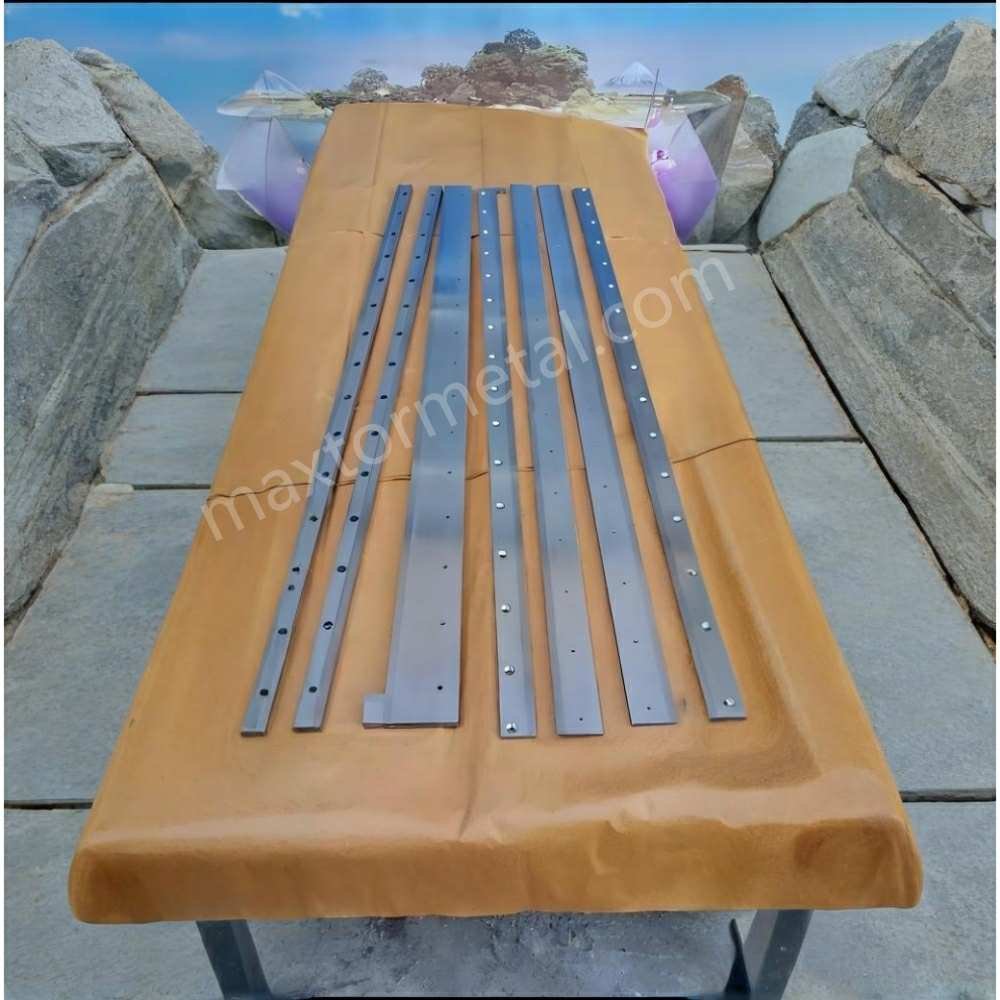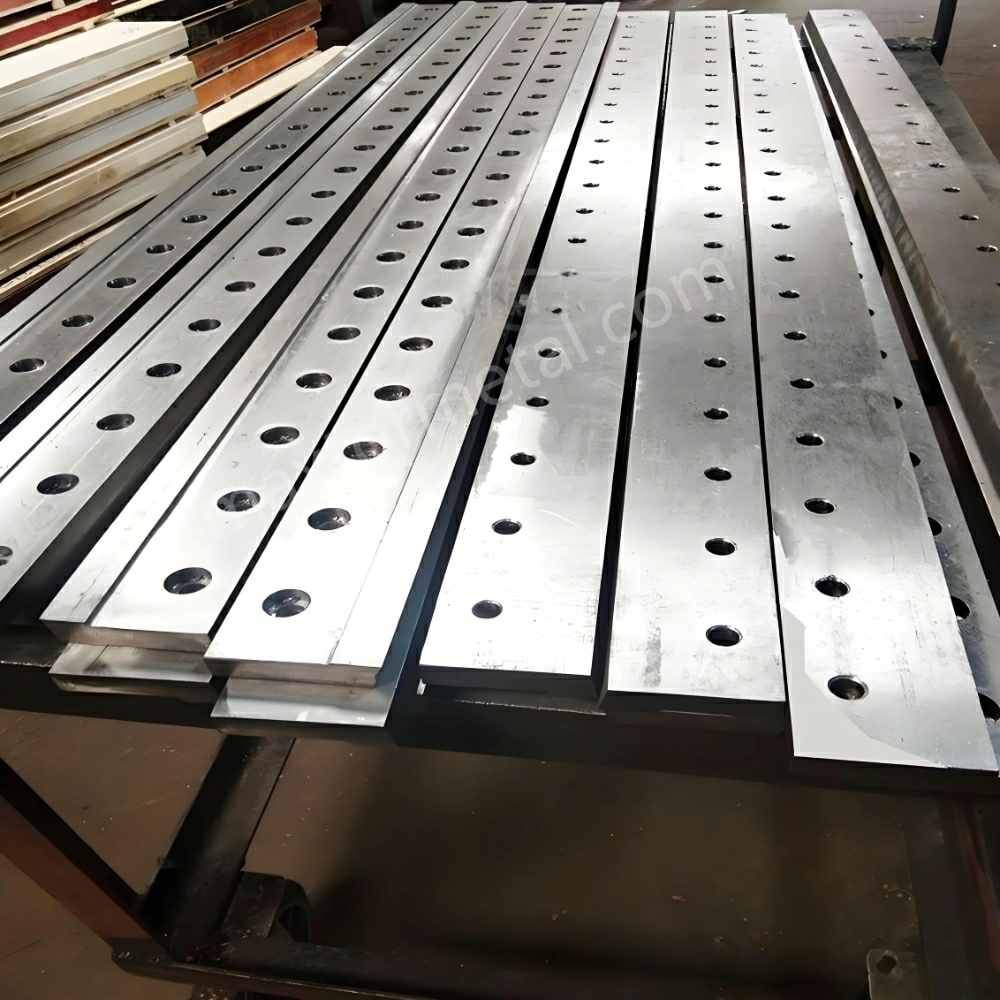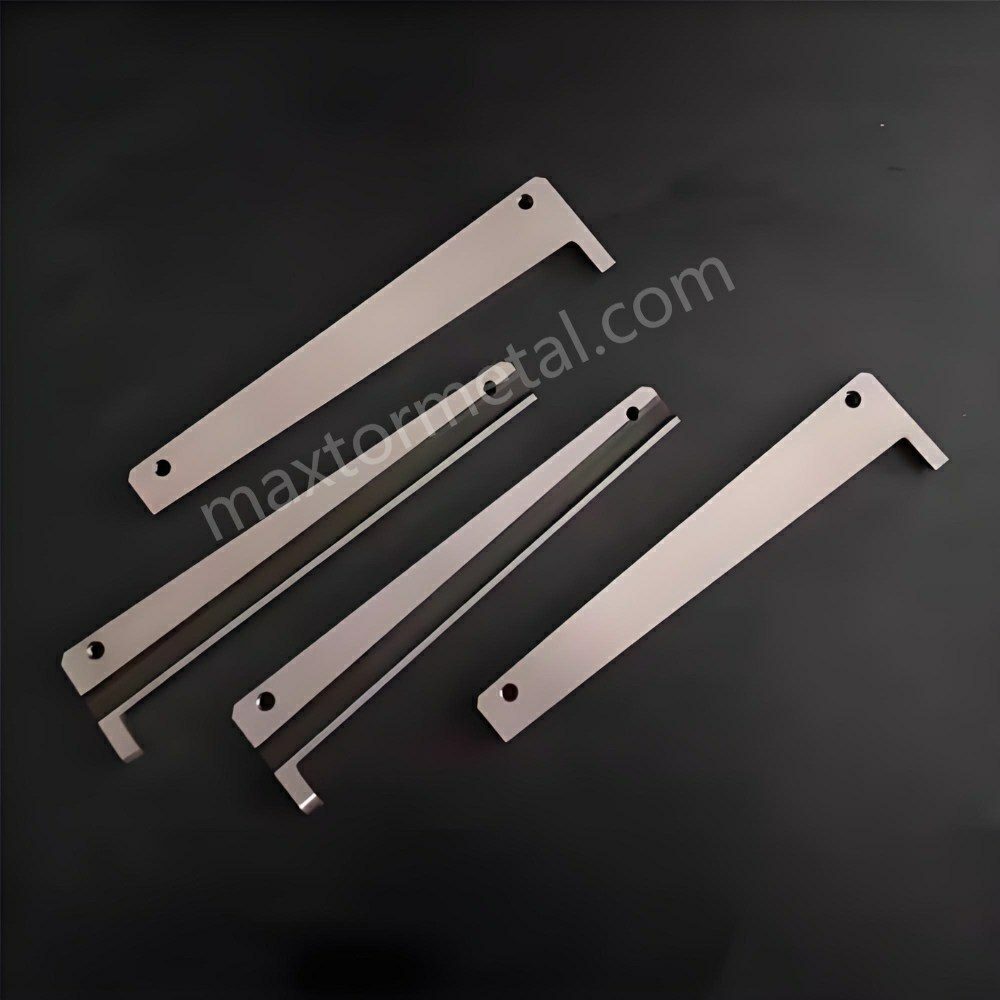
Taking care of and replacing Sheeter Knives is very important. It keeps your work safe and makes things run better. Ignoring this can cause bad cuts, more delays, and even accidents. By following expert tips, you can cut better, stay safe, and make your machines last longer.
Changing knives often costs a lot of time and money. Following OEM rules for knife shape and size helps them last longer and work better.
Handling Sheeter Knives the right way saves both time and money. It also improves your work by checking cuts carefully, lowering complaints, and cutting extra costs. Pick a custom blade from trusted makers like Nanjing Metal to fit your needs and improve your work quality. For more information, feel free to contact us.
Key Takeaways
- Change and care for sheeter knives often for clean cuts. This helps avoid accidents and saves time and money later.
- Use the correct tools when replacing sheeter knives. Good tools like torque wrenches and alignment gauges make installation safe and easy.
- Stay safe by wearing protective gear and following safety rules. Lockout/tagout steps lower the chance of getting hurt by sharp blades.
- Think about using custom sheeter knives for special jobs. They cut better and waste less material, saving money.
- Keep sheeter knives clean and oiled regularly. This makes them last longer and work better, helping you finish tasks faster.
Understanding Sheeter Knives
What Are Sheeter Knives? (Including Alternate Names)
Sheeter knives are special tools used in factories. They cut big rolls of material into neat sheets. People also call them crosscut knives or sheeting blades. These knives are important for industries like paper, packaging, textiles, and printing. They make clean and accurate cuts. Made from strong materials like 65Mn, 9CrSi, and HSS, they handle heavy work while staying precise. Their strength and usefulness make them key tools in many factories.
How Sheeter Knives Work
Sheeter knives cut rolled materials with great accuracy. The machine moves the material to the cutting area. The knife then cuts it to the needed size. Sharp blades and the right angle help avoid waste and dust. Some knives stay still, while others spin to match the material’s speed. This design ensures steady results, even in tough factory jobs.
Applications of Sheeter Knives in Industries
Sheeter knives are used in many industries. In paper factories, they cut rolls into sheets for printing and packing. In textiles, they prepare fabric sheets for making clothes. Packaging companies use them to cut materials like foil and film. These knives are fast and precise, making them very useful.
For example:
- Unifoil used the Maxson DFK sheeter and worked 25-30% faster.
- Better cutting saved over 2% of waste, lowering costs.
- Automation made it possible for one person to operate, improving speed.
These examples show how sheeter knives help factories work better, waste less, and save money.

Tools and Preparation for Sheeter Knives Replacement
Essential Tools for Replacing Sheeter Knives
To replace sheeter knives, you need the correct tools. These tools must match your machine and blade type. Companies like Carolina Knife & Manufacturing and Lenox make tools for the paper and converting industries. Common tools include blade holders, torque wrenches, and alignment gauges.
Here’s a simple table of important tools:
| Manufacturer | Description |
|---|---|
| Carolina Knife & Manufacturing | Makes custom blades and OEM parts for the paper industry. They focus on choosing the right materials and blade styles. |
| Beloit | Produces top and bottom slitter blades using strong materials. |
| Lenox | Supplies OEM tools for converting industries, especially in paper production. |
| GL&V (GLV) | Offers OEM parts for paper conversion machines, ensuring they fit well. |
Using good tools makes replacement easier and protects your machine and blades.
Safety Precautions Before Starting
Safety is very important when working with sheeter knives. These blades are sharp and can hurt you if not handled carefully. Always wear gloves and safety goggles before starting. Turn off the machine’s power to avoid accidents.
Tip: Check your machine’s manual for safety steps. This helps you stay safe while replacing the blades.
Keep your workspace neat and clean. A tidy area helps prevent mistakes and injuries.
Preparing the Machine for Knife Replacement
Getting the machine ready is very important. First, clean the cutting area. Remove dirt or leftover material that could affect the new blade. Check the machine for any damage or worn-out parts. Look for loose screws or misaligned pieces.
Good preparation helps the new sheeter knives work well and last longer. It also keeps your machine in good condition.
Step-by-Step Guide to Replacing Sheeter Knives

Gather Necessary Tools
List of Essential Tools
Before replacing sheeter knives, gather all the needed tools. Using the right tools makes the job easier and safer. Here’s a list of what you’ll need:
- Blade holders: Hold the knives steady while installing them.
- Torque wrenches: Tighten bolts properly without over-tightening.
- Alignment gauges: Help place the knives in the correct position.
- Protective gloves and goggles: Protect your hands and eyes from harm.
Having these tools ready saves time and avoids mistakes during the process.
Importance of Quality Tools
Good tools are as important as having the right ones. Bad tools can harm your machine or cause poor installation. For example, a cheap torque wrench might not tighten bolts well. This could make the knives come loose while working. Using reliable tools ensures accuracy and helps your knives last longer.
Tip: Check your tools for damage before starting. Broken tools can ruin the replacement process.
Ensure Safety First
Wear Protective Gear
Safety is key when working with sharp tools like sheeter knives. Wear gloves to protect your hands from cuts. Use goggles to keep your eyes safe from flying bits. If it’s loud, wear ear protection too.
Disconnect Power Supply
Turn off the machine before changing the blades. This stops it from turning on by accident, which could hurt you. Follow lockout/tagout steps to keep the machine off while you work.
| Safety Steps | What They Do |
|---|---|
| Wear Safety Gear | Gloves, goggles, and ear protection keep you safe. |
| Lockout/Tagout Procedures | Make sure the machine stays off during maintenance. |
| Emergency Buttons | Emergency stops should be easy to find and use. |
| Guard Moving Parts | Cover moving parts to avoid injuries. |
By following these safety tips, you can work safely and finish the job well.
Prepare the Machine
Clean the Work Area
Keep your workspace clean for a smooth replacement. Remove dust, debris, or leftover materials from the cutting area. This helps the new blades fit well and work properly. Cleaning often also stops buildup that could harm the machine.
| Cleaning Steps | Inspection Steps |
|---|---|
| Clean the sheeter regularly | Check for worn or broken parts |
| Replace blades and tools | N/A |
Inspect Machine Components
Check the machine carefully before putting in new knives. Look for loose screws, worn parts, or anything out of place. Fixing these problems first helps the new knives work better and last longer. Regular checks also catch problems early, saving time and money.
Note: A well-prepared machine works better and keeps you safer while using it.

Take Out Old Sheeter Knives
Check the Manual
Always read the manual before starting. It has steps for your machine. Follow these steps to avoid mistakes or damage. Use the tools and methods the manual suggests. Skipping this can cause accidents or poor handling.
Tip: Keep the manual nearby. It helps if you get stuck.
Be Careful with Knives
Sheeter knives are very sharp. Handle them safely to avoid cuts. Wear gloves to protect your hands and hold the knives firmly. Put the removed knives on a flat, safe spot away from your work area. This keeps the workspace tidy and prevents accidents.
Note: Don’t drop the knives. Even small drops can harm the blade’s edge and make it less effective.
Put In New Sheeter Knives
Align Knives Correctly
Alignment is key for clean cuts. Place the new knives using the machine’s alignment marks. Use an alignment gauge to check they are straight and spaced evenly. Misaligned knives can ruin cuts and waste material.
Pro Tip: Check the alignment twice before tightening. Fixing it now saves time later.
Tighten Knives Securely
After aligning, fasten the knives with the right tools. Use a torque wrench to tighten bolts to the settings in the manual. Don’t over-tighten, as it can harm the machine or blades. Loose bolts can make the knives move during use.
Safety Reminder: Check all fasteners after tightening. Loose parts can cause safety problems.
Test the Machine
Run a Test
After installing the knives, start the machine slowly. Watch how it cuts to see if the blades work well. Look for smooth, clean cuts without rough edges. If the cuts aren’t good, stop and check the alignment or installation.
Adjust If Needed
If there are problems, make changes. Realign the knives or tighten bolts again. Test the machine until it works perfectly. Testing and adjusting help your knives last longer and work better.
Final Tip: Write down any changes you make. This record helps with future fixes or maintenance.

Maintenance Tips for Sheeter Knives
Taking care of your sheeter knives is very important. Good maintenance helps them last longer and work better. It also saves time and money by reducing repairs. Follow these simple tips to keep your blades in great shape.
Cleaning Sheeter Knives
Use the Right Cleaning Products
Clean your sheeter knives after every use. Use cleaners made for industrial blades. Avoid strong chemicals that can harm the blade. A mix of warm water and mild soap works well for most dirt. If your blades cut sticky stuff like glue, use a special cleaner that removes it without damage.
Tip: Check the maker’s guide for safe cleaning products to avoid problems.
Wipe Off Residue After Use
Leftover material can make blades dull and cut poorly. After using, wipe the blades with a soft cloth to remove dirt or debris. For tough spots, use a gentle scrub pad. Clean blades work better and last longer.
Pro Tip: Clean your blades at the end of each work shift to keep them sharp.
Lubrication Techniques
Add Lubricant Often
Lubricating your blades is very important. Put a thin layer of oil on the blade and moving parts. This lowers friction and stops rust. Focus on areas where the blade touches other machine parts. Regular oiling keeps your blades in good shape.
Note: Don’t use too much oil. Extra oil can collect dust and dirt.
Pick the Best Lubricant
Not all oils are good for industrial blades. Use high-quality oil made for heavy-duty machines. For food or printing jobs, pick food-safe oil to avoid contamination. The right oil helps blades work well and protects them from damage.
Callout: Spending more on good oil now can save repair costs later.
Inspection Procedures
Look for Worn-Out Blades
Check your blades often for wear and tear. Look for dull edges, cracks, or uneven spots. Worn blades cut poorly and waste material. Inspect them weekly or after heavy use to keep them in top condition.
| Expense Type | Regular Blade Cost | Durable Blade Cost | Savings with Better Blades |
|---|---|---|---|
| Yearly Maintenance Costs | $15,000 | $10,000 | $5,000 |
| Repair Costs | $8,000 | $5,000 | $3,000 |
Insight: Using strong blades can cut maintenance costs by 18% and reduce repairs by 25% over five years.
Check for Blade Damage
Look for cracks or chips in your blades. Damaged blades can hurt your machine and cause accidents. Replace broken blades right away to avoid bigger problems.
Reminder: Keep a record of your checks. This helps you plan when to replace blades.

Sharpening Sheeter Knives
Know When to Sharpen
It’s important to know when your sheeter knives need sharpening. Dull blades make bad cuts, waste material, and strain machines. Check your knives often for worn edges or poor cutting. If cuts look messy or the machine feels harder to use, it’s time to sharpen them.
Tip: Make a plan to check knife sharpness regularly. This keeps your work smooth and avoids delays.
Use Correct Sharpening Methods
Sharpening sheeter knives needs care and the right tools. Professional grinding keeps blades sharp without damaging them. Experts use special machines for the best results.
Here’s a table of sharpening methods:
| Technique/Process | Description |
|---|---|
| Professional Grinding | Experts use machines to sharpen blades safely and well. |
| Abrasive Selection | Picking the right grinding tools avoids harming the blade edges. |
| Assessment Process | Each blade is checked to find the best sharpening method. |
| Cleaning Techniques | Methods like sandblasting clean blades before sharpening. |
| Inspection Procedures | Blades are checked for damage to ensure safe sharpening. |
| Grinding Expertise | Skilled grinding makes blades last longer and resist wear. |
Follow the maker’s rules to avoid over-sharpening, which can weaken blades. If you don’t have the tools or skills, hire experts to sharpen industrial knives.
Pro Tip: Test sharpened knives on a small job first. This ensures they work well before using them fully.
Storage Tips
Keep Knives in a Safe Spot
Storing sheeter knives properly helps them last longer. Put them in a dry, clean place away from dust and moisture. Use a cabinet or rack to keep them safe and organized. Bad storage can cause rust, dull edges, or accidents.
Safety Reminder: Lock the storage area to keep it safe from unauthorized access.
Use Blade Covers
Blade covers protect sheeter knives from damage and dirt. Covers stop moisture and dust from ruining the blades. They also prevent injuries from sharp edges.
Choose strong covers made of rubber or plastic. Make sure they fit tightly to keep the blades safe.
Note: Label each cover with the blade size or type for easy use during maintenance.
Good storage keeps your knives ready to use and reduces maintenance needs. It saves time and keeps your workspace safe.

The Importance of Custom Sheeter Knives
Benefits of Custom Blades for Specific Applications
Custom sheeter knives are made to fit your exact needs. Unlike regular blades, they are designed for specific jobs in your industry. For example, custom blades can cut material waste by up to 30%. This saves resources and lowers costs, making them eco-friendly and budget-friendly.
Custom blades also perform much better than standard ones. Here’s a comparison:
| Metric | Regular Tools | Custom Tools |
|---|---|---|
| Average Roughness (Ra) | 6.21 μm | 2.67 μm |
| Maximum Height (Rz) | 30 μm | 12.5 μm |
| Dimensional Deviation | > 48 μm | < 48 μm |
Although custom blades cost more upfront, they last longer and need fewer repairs. Their smart designs can save up to 50% on costly materials. This makes them a great choice for long-term savings.
How to Choose the Right Custom Knife for Your Machine
Picking the right custom knife takes careful thought. Look for blades that are tough, stay sharp, and resist rust. Tough blades don’t break easily, and sharp ones cut better for longer. A good balance of these traits is important.
Other things to check include how easy the blade is to sharpen and its heat treatment. These affect how well it works and how easy it is to maintain. For food or printing jobs, pick blades that resist rust and are safe for food. Always match the blade to your machine’s needs for the best results.
Why Customization Is Necessary for Optimal Performance
Custom blades solve problems unique to each industry. For example, carbide blades made for specific tasks cut 20-30% better than regular ones. They handle tough materials and reduce machine downtime, making work faster and easier.
Nanjing Metal, with 18 years of experience, makes high-quality custom sheeter knives. Their skilled team works with clients to create blades that meet exact needs. This focus on quality and customization makes them a trusted leader. Learn more about Nanjing Metal.
Custom blades aren’t just extra—they’re essential for better precision, efficiency, and savings.
If you want custom solutions, contact Nanjing Metal’s experts today to find the right blade for your work.
Common Mistakes to Avoid with Sheeter Knives
Tightening Knives Too Much or Too Little
If you tighten sheeter knives wrong, problems can happen. Tightening too much can damage the blade or machine parts. This might cause cracks or shorten the knife’s life. Tightening too little makes the blade loose. A loose blade can move during use, causing bad cuts or accidents.
To fix this, always use a torque wrench. This tool helps you apply the right pressure when tightening. Follow the maker’s instructions for torque settings. Check each bolt after tightening to make sure it’s secure. Tightening correctly improves cutting and helps your machine last longer.
Skipping Safety Steps
Skipping safety steps when using sheeter knives can be dangerous. These blades are very sharp and need careful handling. If you ignore safety, you risk cuts, dropped loads, or getting caught under the blade.
| Cause of Accident | What Happens |
|---|---|
| Missing Guards | Operators can get hurt if guards are not in place. |
| Dropped Loads | Dropping loads can cause injuries, showing the need for safe handling. |
| Safety Measures | Knowing risks helps teams prevent accidents effectively. |
To stay safe, wear gloves and goggles. Turn off the machine’s power before working on it. Make sure all guards are working and in place. Following these steps keeps you and your team safe from harm.

Using Wrong Tools or Parts
Using the wrong tools or parts can hurt your machine and its performance. For example, a bad blade holder can cause misalignment, leading to uneven cuts. Non-OEM parts may not fit well, making your knives less effective.
Always pick tools and parts made for your machine. Good tools like alignment gauges and torque wrenches help with proper installation. Use OEM or trusted brands like Nanjing Metal for replacement parts. Their blades are made for top performance and durability.
Avoiding these mistakes keeps your sheeter knives working well and safely. For expert help or custom solutions, contact Nanjing Metal’s team today.
Taking care of sheeter knives helps machines work their best. Clean and oil them often to avoid friction and keep things running smoothly. Regular maintenance stops problems before they start, making work faster and better. Checking your machine often finds hidden issues and prevents delays.
Always stay safe by wearing gloves and goggles. Turn off the machine before working on it. Align and tighten blades carefully for neat cuts and longer-lasting knives. These steps improve work quality and save money over time.
Need help or custom blades? Contact Nanjing Metal’s experts today!
FAQ
What are Sheeter Knives used for?
Sheeter Knives cut rolled materials into flat sheets. They are used in industries like paper, textiles, and packaging. These knives make clean cuts, reduce waste, and help factories work faster. They are important for making high-quality products.
How often should you replace Sheeter Knives?
Replace Sheeter Knives when cuts are uneven or materials tear. Check them regularly to spot damage early. Following a maintenance plan keeps them working well and lasting longer.
Can you sharpen Sheeter Knives yourself?
You can sharpen Sheeter Knives if you have the right tools. Use special grinding machines for the best results. If you’re unsure, ask experts like Nanjing Metal for safe sharpening help.
Why choose custom Sheeter Knives?
Custom Sheeter Knives fit your machine perfectly. They cut better, waste less material, and last longer. Nanjing Metal makes custom blades for your industry needs. Learn more about Nanjing Metal.
How can you contact Nanjing Metal for Sheeter Knives?
Need help or custom blades? Contact Nanjing Metal’s team. Reach out today for top-quality Sheeter Knives to improve your work.
See Also
How to Select the Right Guillotine Blade for Your Needs
How to Find the Right Industrial Paper Cutting Knives for Your Needs



One Response
Hi, just wanted to say, I enjoyed this post. It was practical.
Keep on posting!